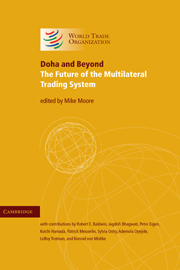Book contents
- Frontmatter
- Contents
- List of contributors
- Introduction
- 1 Trade and sustainable development in the Doha Round
- 2 The WTO: the institutional contradictions
- 3 China's entry into the WTO and its impact on the global economic system
- 4 Key challenges facing the WTO
- 5 Development dimensions in multilateral trade negotiations
- 6 External transparency: the policy process at the national level of the two-level game
- 7 Trading for development: how to assist poor countries
- 8 Controlling corruption: a key to development-oriented trade
- 9 The impact of EC enlargement on the WTO
- Index
1 - Trade and sustainable development in the Doha Round
Published online by Cambridge University Press: 05 August 2012
- Frontmatter
- Contents
- List of contributors
- Introduction
- 1 Trade and sustainable development in the Doha Round
- 2 The WTO: the institutional contradictions
- 3 China's entry into the WTO and its impact on the global economic system
- 4 Key challenges facing the WTO
- 5 Development dimensions in multilateral trade negotiations
- 6 External transparency: the policy process at the national level of the two-level game
- 7 Trading for development: how to assist poor countries
- 8 Controlling corruption: a key to development-oriented trade
- 9 The impact of EC enlargement on the WTO
- Index
Summary
The ‘trade’ agenda
The ‘trade’ agenda has grown inexorably since 1980. In an initial stage, trade negotiations moved from addressing border measures that represented obstacles to trade in goods to behind-the-border measures such as non-tariff barriers (NTBs) or technical barriers to trade. The Uruguay Round took this development one stage further by taking up issues such as trade in services and intellectual property rights (TRIPs) and opening the door on foreign direct investment (FDI). The Doha Declaration may extend this process even further to include competition.
In this expanded trade agenda, the linkages between trade and the environment are everywhere. Indeed, they are so obvious that they are invisible to many. The relationship is largely defined by two fundamental realities:
Both trade – in the narrow sense of ‘trade in goods’ and in the broader sense of the expanded ‘trade’ agenda – and environmental policy are essentially international in character. Much of their interface requires international action, creating unique challenges for trade and international environmental regimes alike.
Trade policy and environmental policy both impact on economic development in complex ways. Ultimately they both create structural economic change, favouring some economic actors over others.
- Type
- Chapter
- Information
- Doha and BeyondThe Future of the Multilateral Trading System, pp. 1 - 18Publisher: Cambridge University PressPrint publication year: 2004

